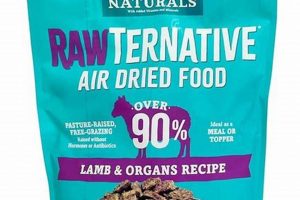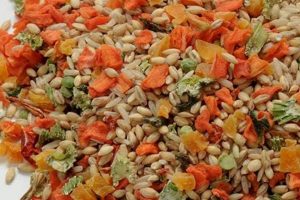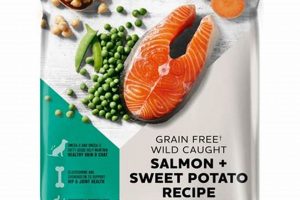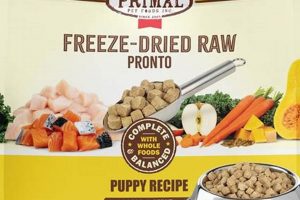Appropriate nutrition formulated specifically for the unique physiological needs of young Great Danes is critical for their healthy development. These specialized diets address the rapid growth phase experienced by this breed, acknowledging their predisposition to skeletal issues and digestive sensitivities during puppyhood. It is a vital element for achieving optimal health outcomes.
The utilization of appropriately formulated sustenance provides numerous advantages, including controlled growth rates that minimize the risk of developmental orthopedic diseases. A diet rich in essential nutrients and balanced with calcium and phosphorus also supports the formation of strong bones and joints. Furthermore, easily digestible ingredients contribute to improved nutrient absorption and reduced gastrointestinal distress, supporting overall well-being during this crucial stage. Historically, the understanding of these nutritional needs has evolved, driven by research into canine physiology and breed-specific health concerns.
The following discussion will examine the key components of an effective nutritional plan, focusing on ingredient selection, appropriate feeding strategies, and potential risks associated with inadequate or excessive nutrient intake. Further, it will explore the role of veterinary consultation in tailoring a dietary regimen to meet the individual needs of each growing Great Dane.
Nutritional Guidelines for Great Dane Puppies
The following guidelines provide essential information for ensuring optimal nutrition during the critical growth phase of Great Dane puppies. Implementing these practices can contribute significantly to their long-term health and well-being.
Tip 1: Choose a Breed-Specific Formulation: Select commercially available options designed specifically for large or giant breed puppies. These formulations typically have a controlled calcium and phosphorus content and a moderate energy density to promote slower, more controlled growth.
Tip 2: Monitor Calcium and Phosphorus Levels: Excessively high levels of calcium can disrupt bone development, increasing the risk of developmental orthopedic diseases. Ensure the calcium to phosphorus ratio is appropriate, ideally between 1.1:1 and 1.5:1.
Tip 3: Control Portion Sizes: Avoid overfeeding, as rapid weight gain exacerbates the risk of skeletal problems. Adhere strictly to the feeding guidelines provided by the manufacturer, adjusting based on individual puppys body condition and activity level. Consult with a veterinarian for personalized recommendations.
Tip 4: Opt for High-Quality Protein Sources: Sufficient protein is vital for muscle development. Select options with readily digestible animal-based protein sources. Avoid those with excessive amounts of plant-based protein.
Tip 5: Provide Multiple Small Meals: Instead of offering one or two large meals, divide the daily ration into three or four smaller meals. This aids in digestion and reduces the risk of bloat, a life-threatening condition common in Great Danes.
Tip 6: Avoid Supplementation Unless Recommended by a Veterinarian: Unless specifically advised by a veterinary professional, avoid supplementing with calcium, phosphorus, or vitamin D. Over-supplementation can disrupt the delicate balance of nutrients required for healthy growth.
Tip 7: Monitor Stool Consistency: Changes in stool consistency can be indicative of dietary intolerance or imbalance. If persistent diarrhea or other digestive issues occur, consult a veterinarian.
Adhering to these guidelines can help mitigate the risk of developmental problems, supporting a healthy and active life for Great Dane puppies. Prioritizing appropriate sustenance sets the foundation for long-term health and skeletal integrity.
The subsequent discussion will explore potential health challenges and strategies for addressing them through targeted dietary management.
1. Controlled Growth Rate
The rate at which a Great Dane puppy grows is directly influenced by its diet, necessitating careful consideration of sustenance composition. Rapid growth, often fueled by excessive caloric intake or inappropriate nutrient ratios, places undue stress on developing skeletal structures. This stress can manifest as developmental orthopedic diseases, including hip dysplasia, elbow dysplasia, and osteochondrosis dissecans. Therefore, the primary objective of appropriate dietary management is to promote a moderate, controlled growth rate rather than maximizing growth velocity. This goal is achieved through specifically formulated nutrition tailored to large-breed puppies.
The composition of dog food formulated for Great Dane puppies is pivotal in achieving a controlled growth rate. Formulations designed for rapid growth, common in small-breed puppy sustenance, are unsuitable. Instead, a diet with moderately restricted calorie density and carefully regulated calcium and phosphorus levels is essential. For instance, a study comparing Great Dane puppies fed a high-calorie diet with those fed a moderate-calorie diet demonstrated a significantly higher incidence of orthopedic problems in the rapidly growing group. This underscores the direct connection between diet composition and skeletal health, highlighting the need for vigilance in ingredient selection and portion control.
Achieving a controlled growth rate in Great Dane puppies through appropriate dietary management is not merely a theoretical consideration; it has profound practical implications. It directly impacts the long-term health, mobility, and quality of life of these dogs. By understanding the connection between sustenance and growth rate, owners can proactively mitigate the risk of crippling orthopedic conditions, ensuring that these magnificent animals can enjoy a long and active life. Implementing these dietary strategies from puppyhood represents a crucial investment in their future well-being.
2. Calcium
The calcium to phosphorus ratio in sustenance formulated for Great Dane puppies is a critical determinant of skeletal development and overall health. An imbalanced ratio, whether an excess or deficiency of either mineral, disrupts the complex process of bone formation, potentially leading to developmental orthopedic diseases. The ideal ratio typically falls between 1.1:1 and 1.5:1, favoring a slightly higher calcium content. Deviations from this range interfere with calcium absorption and bone mineralization, impacting bone density and structural integrity. This makes accurate mineral balancing indispensable in sustenance choices.
The impact of an incorrect calcium to phosphorus ratio manifests in various clinical conditions. Excessive calcium intake, coupled with insufficient phosphorus, inhibits the hormone responsible for regulating calcium and phosphorus levels, leading to abnormal bone remodeling. Conversely, excess phosphorus relative to calcium can trigger secondary hyperparathyroidism, further disrupting bone metabolism. The consequences of these imbalances include osteochondrosis dissecans, hip dysplasia, and hypertrophic osteodystrophy, all debilitating conditions affecting mobility and quality of life. Therefore, careful consideration of this ratio during sustenance selection is essential to minimize these risks.
Achieving the appropriate calcium to phosphorus ratio in sustenance for Great Dane puppies demands vigilance in product selection and adherence to veterinary recommendations. Owners should scrutinize product labels, verifying mineral content and consulting with veterinarians regarding optimal dietary plans. While some owners may be tempted to supplement calcium, such practices are generally discouraged unless specifically directed by a veterinarian, as they can readily disrupt the delicate mineral balance. By prioritizing accurate ratios and avoiding unnecessary supplementation, owners can significantly contribute to the healthy skeletal development and overall well-being of Great Dane puppies, addressing a crucial component of their nutritional needs.
3. Joint Health Support
Great Dane puppies, due to their rapid growth and large size, are predisposed to joint problems such as hip and elbow dysplasia. Therefore, joint health support is an essential component of specialized sustenance. Incorporating specific nutrients known for their chondroprotective properties can aid in cartilage development and maintenance. Glucosamine and chondroitin sulfate, often included in formulations for large breed puppies, are precursors to glycosaminoglycans, key components of cartilage. These substances support the synthesis of new cartilage and inhibit enzymes that degrade existing cartilage. Furthermore, omega-3 fatty acids, particularly EPA and DHA, found in fish oil, exert anti-inflammatory effects that can alleviate joint pain and stiffness.
The preventative impact of dietary joint support is exemplified in long-term studies on large breed dogs. Puppies fed diets supplemented with glucosamine and chondroitin sulfate from an early age exhibited a lower incidence of joint disorders in adulthood compared to those fed standard sustenance. Similarly, inclusion of EPA and DHA has demonstrated reduced levels of inflammatory markers in the synovial fluid of joints, suggesting a protective effect against cartilage damage. Practical application involves selecting sustenance specifically formulated for large breed puppies, meticulously reviewing ingredient lists for glucosamine, chondroitin, and omega-3 fatty acids, and adhering to recommended feeding guidelines.
In summary, proactive joint health support through specialized nutrition represents a cornerstone of preventative care for Great Dane puppies. By including chondroprotective agents and anti-inflammatory compounds, sustenance can mitigate the risk of developing debilitating joint conditions. While dietary interventions are not a substitute for proper breeding practices and regular veterinary care, they constitute a vital component of a comprehensive strategy to ensure the long-term mobility and well-being of Great Danes. The challenge lies in consistently providing appropriate sustenance throughout the puppy’s developmental stages and remaining vigilant for early signs of joint problems, prompting timely veterinary intervention when necessary.
4. Digestibility Considerations
Digestibility significantly influences the nutritional efficacy of sustenance intended for Great Dane puppies. The breed’s propensity for gastric dilatation-volvulus (GDV), commonly known as bloat, necessitates careful ingredient selection and feeding practices. Poorly digestible ingredients contribute to increased gas production in the gastrointestinal tract, elevating the risk of GDV. Additionally, inefficient digestion can lead to nutrient malabsorption, compromising growth and development. The selection of easily digestible protein sources, such as chicken or fish, and the avoidance of excessive fiber or poorly processed grains are paramount. Smaller, more frequent meals, rather than large, infrequent ones, further reduce the burden on the digestive system, mitigating bloat risk and optimizing nutrient uptake.
The practical implications of digestibility considerations extend beyond bloat prevention. Great Dane puppies are susceptible to digestive sensitivities, often manifesting as diarrhea or vomiting. Identifying and eliminating potential allergens or irritants from the diet is crucial. Limited ingredient diets, formulated with a minimal number of carefully selected components, can assist in pinpointing sensitivities. Hydrolyzed protein sources, where proteins are broken down into smaller peptides, reduce the likelihood of triggering an immune response. Furthermore, prebiotics and probiotics can promote a healthy gut microbiome, enhancing digestion and bolstering the immune system. Veterinarian guidance is essential in navigating dietary sensitivities and selecting appropriate sustenance.
In conclusion, digestibility represents a cornerstone of appropriate sustenance management for Great Dane puppies. The interplay between ingredient selection, feeding practices, and individual sensitivities profoundly impacts gastrointestinal health and nutrient absorption. By prioritizing highly digestible ingredients, implementing strategic feeding schedules, and addressing potential sensitivities, owners can mitigate the risk of bloat, optimize nutrient utilization, and promote the overall well-being of these rapidly growing canines. Ignoring digestibility considerations can lead to adverse health consequences, underscoring the importance of informed decision-making and veterinary collaboration.
5. Appropriate Calorie Density
Calorie density within sustenance formulated for Great Dane puppies is a critical factor directly influencing their growth rate and, consequently, their susceptibility to developmental orthopedic diseases. A diet with excessive caloric density provides an overabundance of energy, driving rapid weight gain and placing undue stress on immature skeletal structures. This increased mechanical load contributes to conditions such as hip dysplasia, elbow dysplasia, and osteochondrosis. Therefore, controlling caloric intake through appropriate calorie density in the selected option is vital to mitigating the risk of these debilitating conditions. Commercial sustenance explicitly designed for large-breed puppies generally features a moderately restricted calorie density compared to formulations intended for smaller breeds, aligning with the unique physiological needs of giant breeds like the Great Dane.
The practical implications of appropriate calorie density extend beyond simply preventing rapid weight gain. A controlled growth rate facilitated by lower caloric density allows for more proportional development of bone and muscle, reducing the likelihood of skeletal malformations. For example, studies have shown that Great Dane puppies fed diets with moderate calorie restriction exhibit a significantly lower incidence of hip dysplasia compared to those fed ad libitum or with high-calorie sustenance. Sustenance labels provide calorie information, typically expressed as kilocalories per kilogram (kcal/kg) or per cup. Monitoring portion sizes and adjusting them according to the puppy’s body condition score, in consultation with a veterinarian, ensures that the actual caloric intake aligns with recommended guidelines.
In summation, appropriate calorie density within sustenance designed for Great Dane puppies serves as a fundamental preventative measure against developmental orthopedic diseases. By carefully controlling caloric intake and monitoring growth rates, owners can promote healthier skeletal development and improve the long-term well-being of these giant-breed canines. Challenges remain in consistently selecting sustenance with appropriate calorie density and tailoring feeding regimens to individual puppy needs, underscoring the importance of informed decision-making and ongoing veterinary guidance throughout the critical growth phase.
Frequently Asked Questions
This section addresses common inquiries regarding appropriate sustenance for Great Dane puppies, offering insights into specific nutritional requirements and considerations.
Question 1: Why is specialized sustenance necessary for Great Dane puppies?
Great Dane puppies experience rapid growth, predisposing them to skeletal issues if nutritional needs are unmet. Formulations specifically designed for large-breed puppies control growth rates and provide balanced mineral content.
Question 2: How does calorie density affect Great Dane puppy development?
Excessive calorie density fuels rapid weight gain, placing undue stress on developing joints and bones. Controlled calorie density promotes slower, more proportional growth, reducing the risk of orthopedic diseases.
Question 3: What calcium-to-phosphorus ratio is optimal for Great Dane puppy nourishment?
An imbalance disrupts bone formation, potentially leading to skeletal abnormalities. The ideal ratio typically falls between 1.1:1 and 1.5:1, favoring a slightly higher calcium content.
Question 4: Are supplements necessary for Great Dane puppies?
Supplementation is generally discouraged unless specifically recommended by a veterinarian. Over-supplementation can disrupt the delicate balance of nutrients and negatively impact bone development.
Question 5: How does digestibility impact Great Dane puppy well-being?
Poorly digestible components increase gas production, elevating the risk of bloat (gastric dilatation-volvulus), a life-threatening condition. Easily digestible proteins and controlled fiber content are essential.
Question 6: What role do glucosamine and chondroitin play in sustenance for Great Dane puppies?
These compounds support cartilage development and maintenance, potentially mitigating the risk of joint disorders such as hip and elbow dysplasia. Sustenance enriched with these elements may be a prudent choice.
Appropriate sustenance selection profoundly impacts the long-term health and well-being of Great Dane puppies. Prioritizing specialized nutrition and veterinary guidance is essential for achieving optimal outcomes.
The following section will delve into practical feeding strategies and methods for monitoring your Great Dane puppy’s growth and development.
Dog Food for Great Dane Puppies
The preceding analysis has underscored the paramount importance of selecting appropriate dog food for Great Dane puppies. The unique physiological demands of this giant breed during its rapid growth phase necessitate careful consideration of calorie density, mineral balance, protein sources, and digestibility. Adherence to breed-specific nutritional guidelines is not merely preferential; it is fundamental to mitigating the risk of debilitating orthopedic conditions and promoting optimal health outcomes. Deviation from these guidelines can have profound and lasting consequences on the animal’s well-being.
Given the significant impact of early nutrition on the long-term health of Great Danes, owners are strongly encouraged to consult with veterinary professionals to develop a personalized feeding plan. Vigilance in product selection, meticulous adherence to feeding recommendations, and proactive monitoring of growth and development are essential. The responsible management of nutrition in Great Dane puppies constitutes a crucial investment in their future quality of life, ensuring that these magnificent animals can thrive and reach their full potential.







